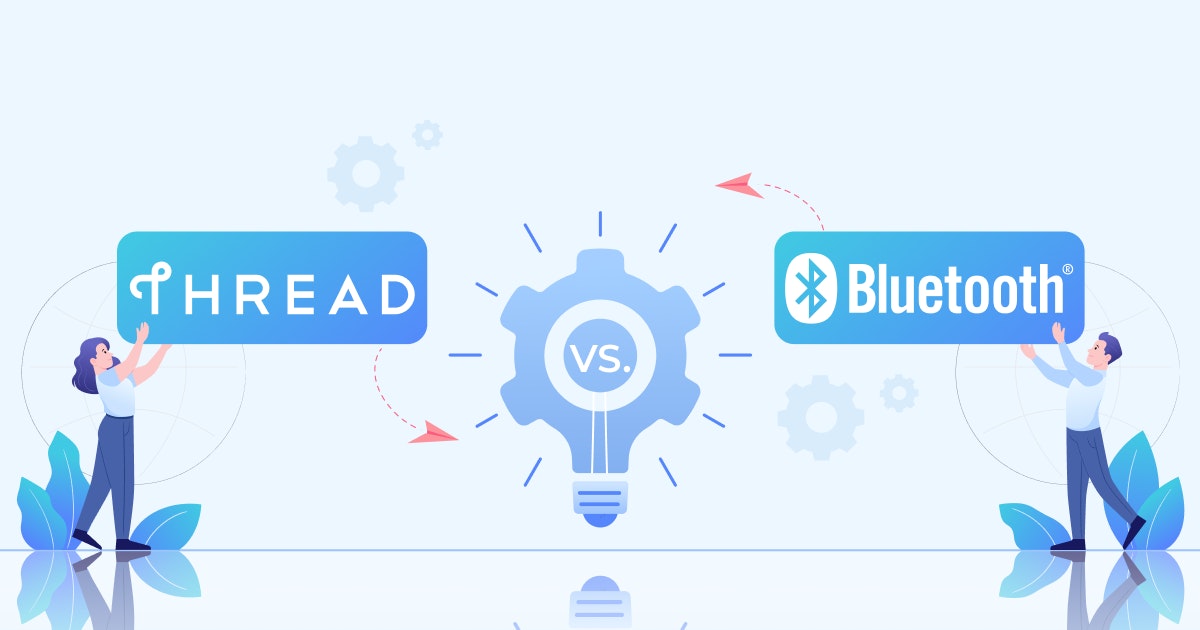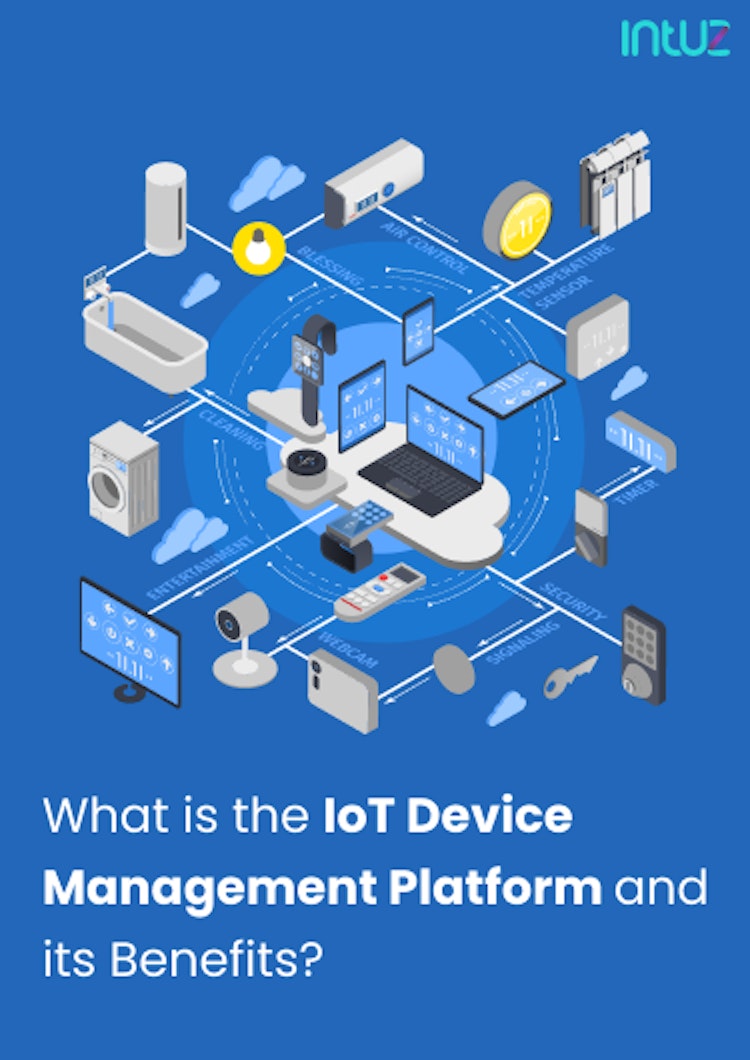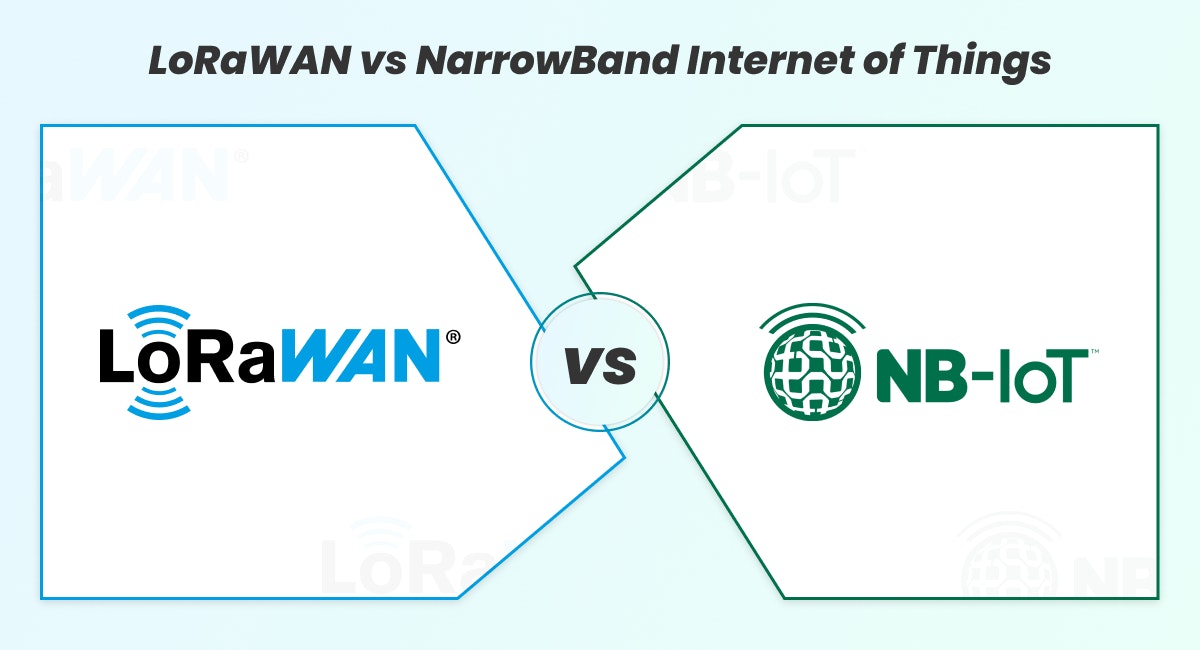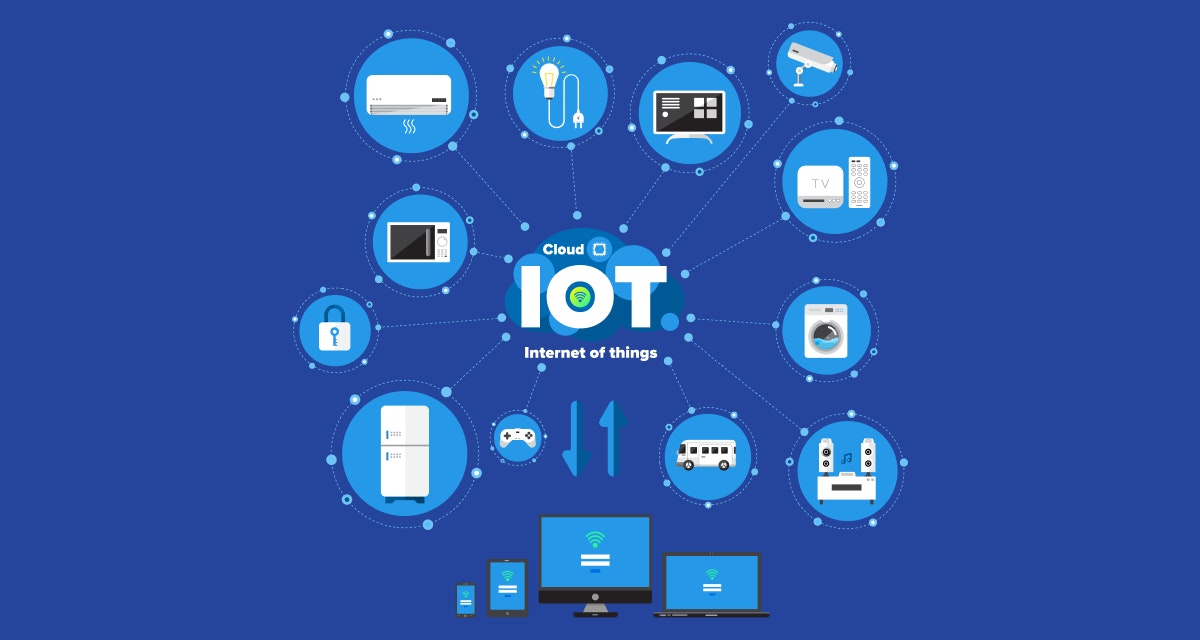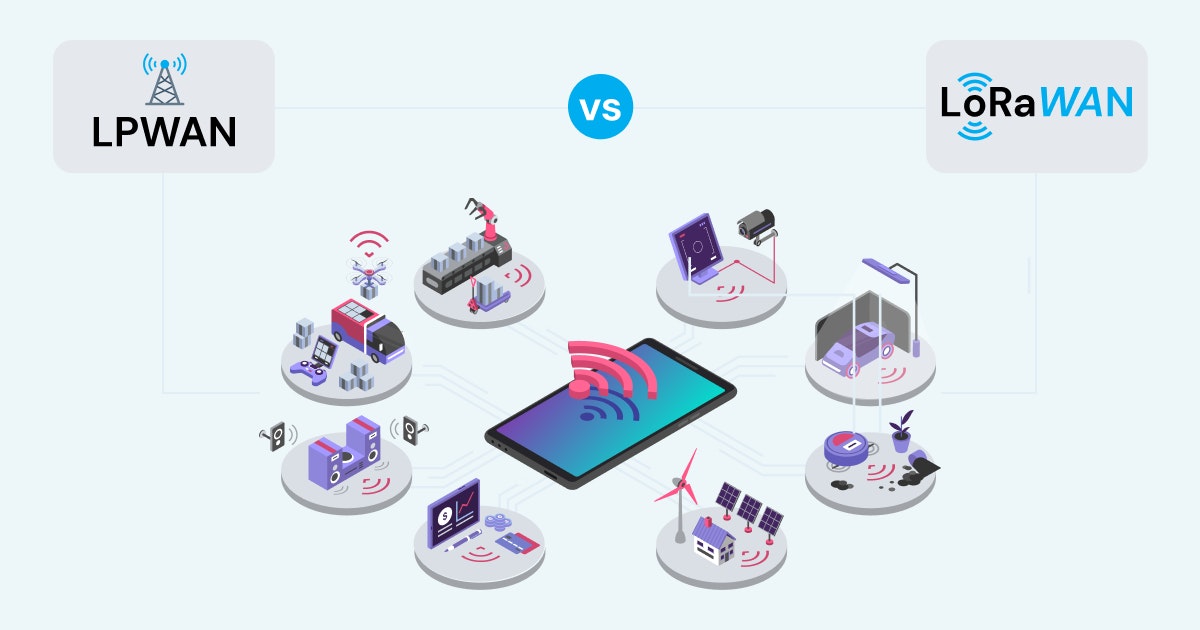Table of Content
The home automation sector has seen tremendous growth over the past few years. Modern appliances from well-known manufacturers such as LG, Samsung, Apple, and Sony now come equipped with some "smart technology." The arrangement has led to IoT wireless devices being more approachable for end-users through their smartphones, tablets, and voice assistants.
Thread and Bluetooth are short-range communication technologies that allow users to communicate with smart home devices. But they are different in the ways they wirelessly connect the devices.
Due to the variations, Thread and Bluetooth serve slightly different purposes in smart home deployments. Let us take a look at how they compare to one another and what factors you should consider before selecting one over the other:
Thread
Thread is an IP-based wireless home automation protocol that was unveiled in July 2015 and was developed by the Thread Group in partnership with industry giants such as Apple, LG, and Google, among others. It functions primarily as a low-power mesh network.

Thread devices, being IP- addressable, use 6LoWPAN in the network layer to assign each Thread device a unique IPv6 address. In addition to making it more straightforward for Thread devices to connect to the internet, this enables direct communication between Thread devices with network connections of up to 250 nodes.
The main advantage of Thread is that it does not need a central gateway to connect to IP because its network can self-heal and auto-reconfigure. Thread makes connecting any device with a network connection simple and eliminates the need for proprietary gateways or translators. This reduces investment and complexity in your infrastructure.
Thread protocol architecture and topology
Routers and endpoints make up Thread networking. Out of these routers connect devices to distribute information across the network. On the other hand, the endpoints can only send data back and forth as they cannot transport data beyond the router. The network supports up to 250 nodes and 32 active routers per network.

These endpoints often run on batteries and include devices such as smart switches, lightbulbs, and plugs. Thread functions as a self-healing and self-maintaining network that automatically adjusts as the user adds, deletes, or physically moves the devices.
IEEE IEEE 802.15.4 MAC/PHY is the foundation of the Thread architecture. A border router establishes connections with other devices on a Thread network structure.
Thread is a complementary technology to WiFi as the latter supports high bandwidth data, such as audio and video while connecting to the internet. Following are the different components of a Thread network architecture:
1. Border routers
The crucial component of a Thread is a border router. It joins the remainder of the home network (i.e., other IP-based networks) to the Thread network. The border routers resemble a hub and follow smart home protocols.
A Bluetooth chipset serves as a backup for all Thread-based devices. Therefore, if a router gets disconnected, the devices will go back to using Bluetooth. A Thread border router minimally supports the following functions: WiFi/Ethernet networks and bidirectional IO connectivity.
Battery life and power consumption are top priorities for all the different battery-operated devices, so the backup Bluetooth devices would connect only if they were initially set up as a Thread device. Thread devices were created explicitly for smart home applications.
2. Lead device
The lead device keeps track of a registry of allocated router IDs. Additionally, it manages requests to promote REEDs to routers. It uses the CoAP protocol, and the Thread routers maintain their state data. It enables the mesh to repair itself in the event of a failure.
3. REEDs
REEDs, also known as Router Eligible End Devices, are essentially the network's leaf nodes or endpoints. Unless they are promoted to a router, they are not in charge of routing or adding devices to the network. In addition, endpoint devices incapable of becoming routers and host devices that have entered a state of sleep may exist. These latter devices can only communicate with one another via a Thread router.
4. Thread routers
Thread routers oversee the mesh's routing services and never go to sleep unless they are permitted to be degraded to REEDs.
5. Thread network stack
The OSI model's network layers are addressed by the Thread. The OSI model standardizes communication systems by placing applications at the top and hardware and physical components at the bottom.
Thread does not specify the top application layer but uses IEEE Standard 802.15.4 for the physical (PHY) and media access control (MAC) levels. It can be used with the same radio modules already supporting 802.15.4 and works in the Industrial, Scientific, and Medical (ISM) 2.4GHz frequency band.
Distance Vector Routing and mesh link setup are two stack components included in the Thread, which utilizes the User Datagram Protocol (UDP) with IP routing to deliver packets more quickly.
Benefits of Thread
Thread offers a network for devices to operate on. It works along with Matter, which, in turn, provides the connection protocol facilitating device interoperability. Thread has the following benefits:
- With no single point of failure and the ability to scale to hundreds of devices, Thread delivers reliable self-healing IoT mesh networks. Simplify the complexities of Thread IoT by addressing specific challenges, such as security, interoperability, and reliability.
- Bank-grade security is offered by Thread networks. Thread closes security gaps and makes the operation hassle-free.
- Installing Thread devices is straightforward and makes use of a smartphone, tablet, or computer. The end-users may safely link their Thread devices at home to the cloud and other devices for convenient control and access from any location.
- Thread facilitates battery-operated devices, enabling everyday gadgets such as thermostats, lighting controls, safety devices, and security equipment to connect to the network without constant charging or regular battery changes.
- Thread supports faster time to market as it leverages the same set of tools available on the internet. Since it is application-layer agnostic, Thread allows the application layer and the cloud services of the Thread smart devices to change over time.
Limitations of Thread
It cannot accommodate very high data rates, which is not the case with WiFi. Thread does not support extremely long range. The maximum allowed number of gadgets on the network is only 250, a massive letdown if you compare the 65560 devices supported by Zigbee. Thread has a comparatively high latency.
Bluetooth
Bluetooth is a short-range wireless technology standard used for exchanging data between stationary and mobile devices over short distances. It is a low-power communication channel used for smart building deployments.

It refers to any mesh network that links devices together over Bluetooth and uses Bluetooth LE to function. It is a wireless communication technology with a short range and low power that communicates at the 2.4GHz frequency band.
Bluetooth supports varied device communication and makes use of a managed flood-based method, which reduces power consumption by only allowing mains-powered nodes to relay messages, which are guaranteed to arrive at their destination even if some nodes are offline.
How does Bluetooth architecture work
Bluetooth technology has been in existence since 1994, when Dutch engineer, Jaap Haartsen, laid down the foundations for Bluetooth, enabling connections between a seemingly endless array of devices. The Bluetooth architecture comprises two types of networks, such as Piconet and Scatternet:
1. Piconet
Piconet is a Bluetooth network containing a master node and seven slave nodes. As a result, a piconet can support up to eight active nodes (1 master and seven slaves) or stations. Each piconet can have only one primary or Master station.
The Master controls when a slave device may broadcast and is the one who starts communication with other devices. Everything is communicated between a master and a slave, and it is not possible to communicate between slaves.
2. Scatternet
Scatternet is created by combining several piconets. One piconet's secondary station may serve as the primary in another. It can deliver messages to secondaries in the other piconet while receiving messages from the primary in the first piconet.
A single station cannot be a master in two piconets. The protocol stack is said to be the heart of Bluetooth technology. The protocol stack defines how the technology functions and how it is used to complete tasks.
By adding new levels to the stack, Bluetooth has progressed from a replacement for RS-232 data lines to a robust and expansive Bluetooth connectivity solution for IoT.
As an extension of the Bluetooth Core ("classic") specification, the newest Bluetooth specification for IoT, Bluetooth mesh, must be built over either the BLE 4.xx or 5.xx stack. Therefore, there are three stack layers in the newly emerging Bluetooth mesh stack: Core, BLE, and mesh.
How Bluetooth enhances the IoT architecture
Since a typical IoT infrastructure comprises hardware, firmware, and software, Bluetooth acts as the communication layer, which is a critical bridge between the layers and includes a multi-layer stack, including session protocols, data links, and the network.
Bluetooth is a part of the data link layer, connecting either sensor to gateway or sensor to sensor. On the other hand, the network layer is accountable for routing or moving data packets across the network, using the most relevant paths. The session layer protocols enable messaging across various elements of the IoT communication subsystem.
Layer Architecture of Bluetooth
The functionality of the Bluetooth network protocol stack is divided between these main layers: Application Profiles, the Controller, the Host, and Services. Here is what the layer architecture of the Bluetooth technology looks like:

1. Radio layer
This is responsible for the modulation or demodulation of data for transmitting or receiving over radio frequencies in the 2.4 GHz band. The radio layer outlines the physical features that Bluetooth transceivers have - connectionless and connection-oriented physical linkages are the two categories defined.
2. Baseband link layer
Comparable to the MAC sublayer in LANs, the baseband is the digital heart of a Bluetooth system. Within a piconet, it handles the connection establishment with relative ease and convenience.
3. Link manager protocol layer
It handles link management, including authentication and encryption procedures, for already-established links. It is in charge of establishing the links, monitoring their condition, and gently cutting them off in case of failure or upon request.
4. Logical link control and adaptation protocol layer
It is also referred to as the Bluetooth protocol stack's "heart." The layer enables the stack's upper and lower layers to communicate by assembling the data packets received from higher layers into the shape that lower layers require. Segmentation and multiplexing are additional functions of the said layer.
5. SDP layer
SDP is short for Service Discovery Protocol. The layer makes it possible to learn about the services offered by other Bluetooth-enabled devices.
6. RF comm layer
The abbreviation "RF comm" stands for Radio Frontend Component. With OBEX and WAP, the layer offers a serial interface. Additionally, it provides serial port emulation via the logical link control and adaptation protocol (L2CAP). The ETSI standard TS 07.10 is upon which the communications protocol is built.
7. Application layer
This one is simple. The application layer is what users use to interact with the application.
Bluetooth vs. WiFi — Which Is Better For Connectivity For IoT Development?
Learn MoreAdvantages of Bluetooth
Bluetooth is a brilliant form of wireless technology that has taken "hands-free" communications to a whole new level. For those of you still confused about the benefits it brings to the table, here is what you must know:
- Bluetooth can wirelessly communicate data between devices. It works brilliantly with laptop computers and other portable devices. There is no requirement for connecting cables.
- With a large number of Bluetooth applications now in the mix, it shows that the technology is widespread and readily available.
- It has low-power consumption. This is great for mobile device users for additional battery power, allowing them to enjoy longer talk times.
- Bluetooth is the standardized wireless protocol, meaning it is employed for the transmission of voice and data and is compatible with nearly any wireless data.
- The cost of Bluetooth devices is relatively low. Developers can quickly implement the technology in their devices.
Disadvantages of Bluetooth
Security is perhaps one of Bluetooth's main drawbacks. This is because it uses radio frequency technology to work and, therefore, can penetrate through walls. Bluetooth is not advisable for use for critical business or personal data transfer. However, there are other disadvantages of Bluetooth as well, including:
- In some circumstances, the connection may be lost.
- Bluetooth has low bandwidth.
- Only short-range communication between devices is permitted in Bluetooth.
Bluetooth Low Energy and Bluetooth topologies
Bluetooth Low Energy, or BLE, also known as Bluetooth smart, is the name given to Bluetooth version 4.0. It is a low-power variant of the first established Bluetooth standard. BLE devices cannot communicate with conventional Bluetooth devices since they are incompatible.
The 2.4 GHz ISM band is where BLE functions, just like Bluetooth. But unlike standard Bluetooth, BLE is always in sleep mode unless a connection is started. Applications that do not need to exchange high volumes of data typically employ BLE because it can operate for years on battery power at a lower cost.
Top Bluetooth topologies
- Point-to-point is used for establishing one-to-one (1:1) device communications.
- Broadcast is used for setting up one-to-many or 1:m device communications easily.
- Mesh connects many-to-many (m:m) device communications.
Thread vs. Bluetooth: Which is a better technology?
Thread is an IoT low-power, low-latency mesh networking technology-based 6LoWPAN standard that enables direct communication between devices. Thread is built on IPv6 that allows end-to-end routing and addressability within a network or between networks without requiring extra translation layers to be put in place.
BLE, often known as Bluetooth Smart, strongly emphasizes low-power consumption. BLE mesh is a short-range network topology for BLE wireless communications developed on top of Bluetooth (LE) standards. A tablet or smartphone can connect to the cloud via a Bluetooth mesh device that supports Bluetooth Low Energy.
Thread is IP-addressable, which is its most advantageous feature. It enables the Thread network to have a reasonably high data rate. However, gadgets not dependent on IP are less vulnerable to security issues than internet-connected devices.
They can be secured with less stringent security measures and lower security overhead. That is why Bluetooth benefits here. The Thread network can support over 250 devices with several hops. In contrast, Bluetooth enables the establishment of considerably bigger networks.
The Bluetooth Special Interest Group developed the BLE mesh. The Thread was developed by the Thread Group, which also consists of the businesses Apple, LG, Siemens, and Google.
As these are some of the most important companies, the standard will be adopted by other manufacturers of linked items much more quickly and powerfully. Come, let us get a bird's eye of their differences:

Over to you
It is undeniable that Thread has the support of essential parties. However, it is still too early to make a guarantee. Both low-power internet connection protocols have their advantages and disadvantages, and it is yet unclear which protocol will be preferred by users and the market.
While companies such as Google and Apple back Thread, Bluetooth also has a massive backing. Hence, the end-users will have to choose a side independently because there is currently no standard. Therefore, who will eventually win the connection battle is presently unknown.
Whether you want an expert to share their opinions on Thread or Bluetooth, or you want to develop an IoT product of your own, get started with us today!
